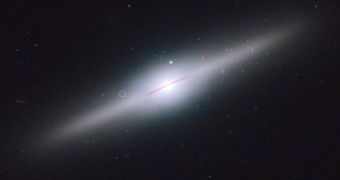Astronomers at the Harvard-Smithsonian Center for Astrophysics (CfA) may have stumbled upon the remnants of a violent cosmic event that occurred billions of years ago. They discovered a cluster of blue stars encircling an intermediate-mass black hole, which is an extremely rare object.
Small, stellar-mass and supermassive black holes are common throughout the Universe, but only a handful of intermediate-mass ones are known to date. None of them is host to a cluster of blue stars.
According to the research team, it could be that the cluster is all that remained of the dwarf galaxy in which the black hole originally developed. As it grew, the dark behemoth simply ripped the galaxy apart, destroying it from within.
Scientists are very interested in the results of such studies, because the evolutionary connection between supermassive black holes and galaxies is still very poorly understood. Studies conducted on this issue often yield contradictory data.
Information collected thus far appears to indicate that the star cluster around the black hole is extremely young, at only 200 million years. A possible explanation for how they appeared is that they formed when the dwarf galaxy that originally created the black hole collided with another galaxy.
Such processes usually lead to the smaller galaxy being absorbed by the larger one. At the same time, inert hydrogen gas from both structures comes together and collapses into new stars. This may explain the extremely young cluster.
If this line of thought is correct, then the fate of the black hole, called HLX-1 (Hyper-Luminous X-ray source 1), is uncertain right now. Astronomers have yet to establish its path, so they can't say for sure where it's headed. What's certain is that it carries the star cluster with it.
Data from multiple telescopes indicate that the object tips the scales at around 20,000 solar masses. It lies at the very edge of ESO 243-49, a galaxy located some 290 million light-years from Earth. This proximity is what made researchers propose the collision scenario in the first place.
HLX-1 was discovered simultaneously by the European Space Agency's XMM-Newton X-ray Observatory, the NASA Swift X-ray observatory, and the NASA/ESA Hubble Space Telescope (in optical wavelengths). The object was first identified in 2009.
“This black hole is unique in that it's the only intermediate-mass black hole we've found so far. Its rarity suggests that these black holes are only visible for a short time,” says Mathieu Servillat, an expert who worked at CfA while the investigation was conducted.
Details of the new research appear in the February 15 issue of the Astrophysical Journal Letters.

 14 DAY TRIAL //
14 DAY TRIAL //